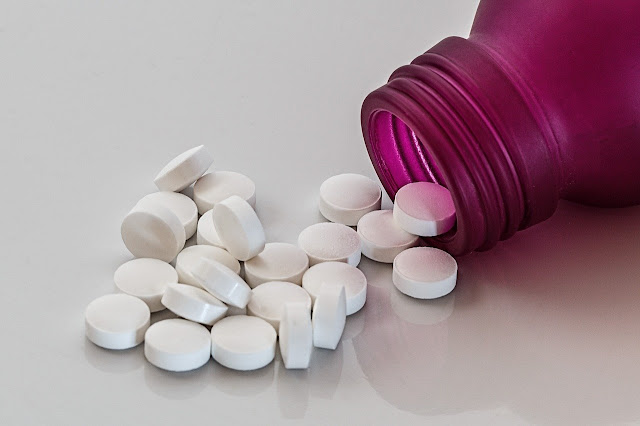 |
| Telmisartan |
Introduction to Telmisartan
Telmisartan is an angiotensin receptor blocker (ARB) medication primarily used
for the treatment of hypertension or high blood pressure. It works by blocking the
action of angiotensin II, a hormone that narrows blood vessels and causes blood
pressure to rise. By blocking this hormone's effects, telmisartan helps blood
vessels relax and widen, lowering blood pressure. Telmisartan was first
approved by the U.S. Food and Drug Administration in 1998 and is available as a
generic medication. It comes in tablet form and is taken once daily, with or
without food.
Mechanism of Action
Angiotensin II is produced by an enzyme known as angiotensin-converting enzyme
(ACE). It causes blood vessels to tighten or constrict, increasing blood
pressure. Telmisartan selectively blocks the binding of angiotensin II to the
angiotensin II type 1 (AT1) receptor in the blood vessel walls. By preventing
the binding and activation of these receptors, telmisartan stops angiotensin II
from narrowing blood vessels. This allows the vessels to widen and lowers
resistance to blood flow, hence reducing blood pressure. Telmisartan has a
longer duration of action compared to other ARBs, providing 24-hour blood
pressure control with once-daily dosing.
Efficacy in Clinical Trials
Numerous clinical trials have demonstrated Telmisartan
efficacy in reducing both systolic and diastolic blood pressure in patients
with mild to moderate hypertension. In one pivotal 8-week study, telmisartan
40-80 mg daily was shown to reduce systolic BP by 9.1-13.7 mm Hg and diastolic
BP by 6.1-8.4 mm Hg compared to placebo. Other trials proved its
non-inferiority to various ARBs and ACE inhibitors. Telmisartan has also shown
added benefits when used in combination with other classes of BP-lowering drugs
like hydrochlorothiazide and amlodipine. A large outcome study further confirmed
its effectiveness in reducing major adverse cardiovascular events in high-risk
patients.
Additional Benefits Beyond BP Control
Research suggests telmisartan provides benefits beyond just lowering blood
pressure. It may help protect endothelial function by reducing oxidative
stress. Several clinical studies demonstrated its ability to improve parameters
of insulin sensitivity and reduce waist circumference in prediabetic and
hypertensive patients, indicating a potential role in preventing or delaying diabetes.
Telmisartan was also found to decrease liver fat content and attenuate
non-alcoholic fatty liver disease in hypertensive patients. Ongoing research
explores its anti-inflammatory and anti-atherosclerotic properties that may
impart added cardiovascular protection.
Adverse Effects and Safety
Telmisartan is generally well-tolerated, with a safety profile similar to other
ARBs. Common side effects reported in clinical trials include upper respiratory
tract infection, back pain, dizziness, and diarrhea. These are usually mild and
do not often require discontinuation of the medication. Rare but serious
adverse reactions can include kidney problems, elevated liver enzymes, low
blood pressure with dizziness upon standing, and allergic reactions like rash or
swelling. As with all BP medications, telmisartan use in pregnancy should be
avoided due to the risk of fetal harm. Overall, its favorable efficacy and
safety make telmisartan an excellent treatment option for hypertension and many
cardiovascular conditions.
Dosage Forms and Administration
Telmisartan comes as 20 mg, 40 mg, and 80 mg tablets to be taken once daily by
mouth without regard to meals. Most patients start on the 40 mg strength which
can be increased up to 80 mg if needed to achieve BP control. The maximum
recommended dose is 80 mg per day, but some individuals may require multiple
antihypertensive drugs to reach their goal blood pressure. Lower starting doses
of 20-40 mg are preferred in elderly patients, those with impaired kidney
function, or moderate to severe liver disease. Telmisartan can be taken with or
without food but should always be swallowed whole and not crushed or chewed due
to its bitter taste.
Drug Interactions
Telmisartan's interactions with other medications are generally mild. However,
some drug combinations should be avoided or require close monitoring. It should
not be taken with aliskiren-containing medicines due to the increased risks of
severe low blood pressure, kidney problems, and stroke. Angiotensin receptor
blockers like telmisartan may also raise potassium levels when combined with
potassium supplements or salt substitutes containing potassium. Nonsteroidal
anti-inflammatory drugs used long-term can decrease its antihypertensive
effects. Lithium clearance may be reduced, warranting lithium level monitoring.
Close surveillance is advised when telmisartan is initiated in those on
diuretics to prevent excessive drops in blood pressure. As always, patients
should inform all physicians about all prescription, over-the-counter drugs,
and herbals they are taking.
Telmisartan serves as an important first-line and add-on treatment for
hypertension and reduces cardiovascular risk through multiple mechanisms beyond
blood pressure control alone. With its once-daily dosing, tolerable safety
profile, and ability to lower both systolic and diastolic pressure compared to
placebo, telmisartan represents an excellent therapeutic option for many
patients with high blood pressure or related conditions like heart failure and
kidney disease. Its effectiveness has been demonstrated across diverse
populations in numerous clinical trials over the past two decades. When used
appropriately, telmisartan offers hypertension management with a high
benefit-risk ratio for improved patient outcomes.
Get More Insights On This Topic: Telmisartan
